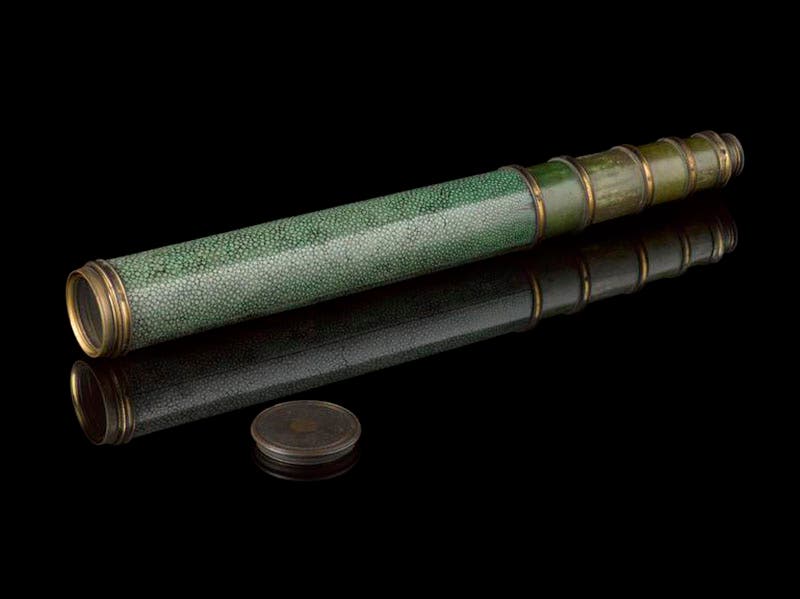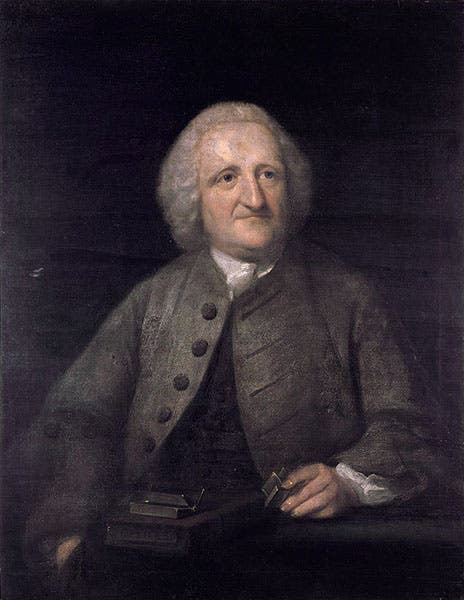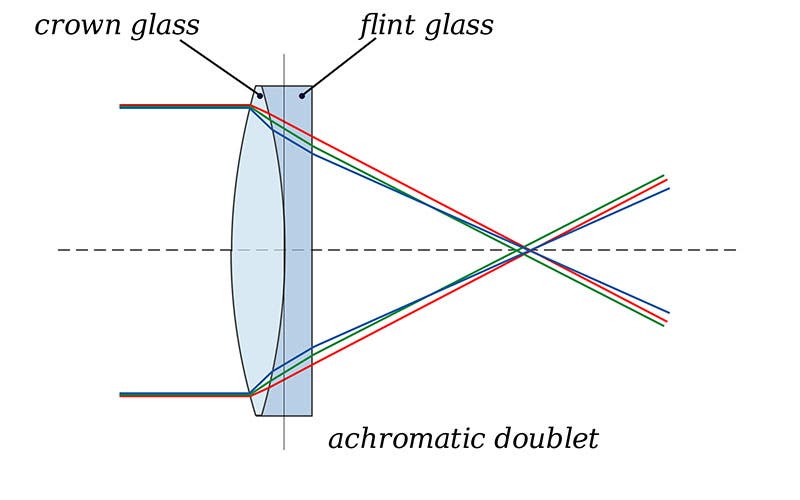Scientist of the Day - John Dollond
John Dollond, an English instrument maker, died Nov. 30, 1761, at age 55. In 1758, Dollond announced his invention of a true "achromatic" telescope. Isaac Newton, almost a century earlier, had demonstrated that when light goes through a prism, it is broken up into its constituent colors. Since a telescope lens is in effect a prism, this means that a lens will focus the differently colored rays to different focal points (third image). An image of a star will never be in true focus; it will always be surrounded by a red or blue halo, depending on which focal point you choose. This inherent distortion in a lens came to be called "chromatic aberration," and Newton and many others thought that it was an irremediable defect, and that refracting telescopes – those that use lenses – were doomed. Some, like Leonhard Euler, disagreed – after all, the human eye, which uses a lens, does not seem to suffer from chromatic aberration. But most telescope makers in the 1750s were concentrating their attentions on producing reflecting telescopes, which use mirrors to focus the light, and do not suffer from chromatic aberration.
Dollond discovered that lenses made of different kinds of glass bend light rays at different angles. He wondered if it might be possible to come up with a combination lens, in effect two lenses nestled together, made of two kinds of glass, so that the colors dispersed by the first lens are put back together by the second, cancelling out the color distortion. Dollond experimented with combinations of concave and convex lenses made of flint glass and crown glass, and by 1758 had come up with an "achromatic doublet," which showed no color dispersion (fourth image). He installed it as the objective (the front lens) in a telescope, and the result was an achromatic telescope. He read a paper to the Royal Society announcing the result of his experiments, and he secured a patent on his achromat. The refractor was back.
It sounds like a simple story of invention by persistence and ingenuity, but it turns out that matters were not so simple after all. An Englishman named Chester Moor Hall around 1730 had already come up with the idea of an achromatic doublet, and had commissioned flint and crown lenses from lens makers, but he was unable to construct an achromatic telescope himself. A Swedish mathematician named Samuel Klingenstierna had derived the exact curvatures needed in a doublet to bring the dispersed rays back together again, and had communicated his results in 1755 to Dollond, who never mentioned this. After Dollond’s death in 1761, when his son Peter started to enforce the patent, scores of London instrument makers challenged the patent in court. The challengers maintained that Moor Hall was the true inventor of the achromatic telescope, and that telescopes had been constructed based on Moor Hall's work long before Dollond had built his own. The court threw out the suit, on the dubious grounds that although Moor Hall did invent an achromat, he did not bring it to market, so it was as if he had never invented it at all. A prominent instrument maker, Jesse Ramsden, then charged that Dollond had known all about Moor Hall's work and had stolen the invention from him, and Peter Dollond wrote a impassioned defense of his father’s originality in 1789, attempting to refute all of Ramsden’s charges.
The question of who invented the achromatic telescope continues to be hotly debated right up to the present, as new bits of evidence come to light, and old bits are reinterpreted. While there is no consensus as to who deserves credit for the achromatic telescope, it would seem that there is general agreement that John Dollond did independently construct an achromatic telescope based on his own experiments and calculations, that he did not steal from Moor Hall or Klingenstierna, and that the telescopes built and sold by Dollond and Company in the late 18th-century were the finest achromats available, even after the patent expired in 1772, and they were used by many prominent astronomers, such as Charles Messier, pioneer in the study of nebulae. You can find Dollond telescopes in most museums of scientific instruments, such as the example we show here, in the Science Museum, London (first image). The name Dollond is usually finely engraved on the brass barrel that holds the eyepiece, as with the Dollond achromat sold by Sotheby’s in 2021 (fifth image).
I do not know the cause of Dollond’s early death, and I could not discover the location of his grave, if it is known. Nor do I know the circumstances of the painting of Dollond’s portrait by Benjamin Wilson, presumably a posthumous portrayal, that is in the Royal Museums, Greenwich (second image). If any reader can fill us in on any of this, I would be happy to update this post.
William B. Ashworth, Jr., Consultant for the History of Science, Linda Hall Library and Associate Professor emeritus, Department of History, University of Missouri-Kansas City. Comments or corrections are welcome; please direct to ashworthw@umkc.edu.











